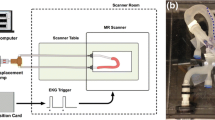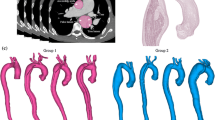Abstract
Aortic dissections are challenging for it remains perplexing to determine when surgical, endovascular, or medical therapies are optimal. We studied the effect of the multilayer flow modulator (MFM) device in patients with different forms of type-B aortic dissections. CT scans were performed pre-, immediately post-MFM implantation, and multiple times within a 24-month follow-up. Three-dimensional reconstructions were created from these scans and the multilayer or single-layer mesh device placed virtually into the true lumen. We observed that MFM device can sufficiently restore flow perfusion, reduce the false lumen, eliminate local flow recirculation, and reduce wall shear stress distribution globally. Single-layer devices can reduce false lumen dimensions; however, they generate local disturbance and recirculation zones in selected areas at specific time points. Moreover, in polar extremes of dissection, the MFM device restored flow to vital organs perfusing vessels independent of effects on luminal patency. Management of aortic dissections should focus on modulation of blood flow, suppression of local recirculation, and restoration of vital organ perfusion rather than primarily restoring vascular lumen morphology. While the latter restores the geometry of the true lumen, only the former restores homeostasis.

Graphical abstract










Similar content being viewed by others
References
Criado FJ (2011) Aortic dissection: a 250-year perspective. Tex Heart Inst J 38:694–700 http://www.ncbi.nlm.nih.gov/pubmed/22199439
Fattori R, Cao P, De Rango P, Czerny M, Evangelista A, Nienaber C, Rousseau H, Schepens M (2013) Interdisciplinary expert consensus document on management of type B aortic dissection. J Am Coll Cardiol 61:1661–1678. https://doi.org/10.1016/j.jacc.2012.11.072
Braverman AC (2010) Acute aortic dissection: clinician update. Circulation. 122:184–188. https://doi.org/10.1161/CIRCULATIONAHA.110.958975
Hiratzka LF, Bakris GL, Beckman JA, Bersin RM, Carr VF, Casey DE Jr, Eagle KA, Hermann LK, Isselbacher EM, Kazerooni EA, Kouchoukos NT, Lytle BW, Milewicz DM, Reich DL, Sen S, Shinn JA, Svensson LG, Williams DM (2010) 2010 ACCF/AHA/AATS/ACR/ASA/SCA/SCAI/SIR/STS/SVM guidelines for the diagnosis and management of patients with thoracic aortic disease. A Report of the American College of Cardiology Foundation/American Heart Association Task Force on Practice Guidelines, A. J Am Coll Cardiol 55:e27–e129. https://doi.org/10.1016/j.jacc.2010.02.015
Erbel R, Alfonso F, Boileau C, Dirsch O, Eber B, Haverich A, Rakowski H, Struyven J, Radegran K, Sechtem U, Taylor J, Zollikofer C, Klein WW, Mulder B, Providencia LA (2001) Diagnosis and management of aortic dissection. Eur Heart J 22:1642–1681. https://doi.org/10.1053/euhj.2001.2782
Nordon IM, Hinchliffe RJ, Loftus IM, Morgan RA, Thompson MM (2011) Management of acute aortic syndrome and chronic aortic dissection. Cardiovasc Interv Radiol 34:890–902. https://doi.org/10.1007/s00270-010-0028-3
Vendrell A, Frandon J, Rodiere M, Chavanon O, Baguet JP, Bricault I, Boussat B, Ferretti GR, Thony F (2015) Aortic dissection with acute malperfusion syndrome: endovascular fenestration via the funnel technique. J Thorac Cardiovasc Surg 150:108–115. https://doi.org/10.1016/j.jtcvs.2015.03.056
Midulla M, Fattori R, Beregi JP, Dake M, Rousseau H (2013) Aortic dissection and malperfusion syndrome: a when, what and how-to guide. Radiol Med 118:74–88. https://doi.org/10.1007/s11547-012-0815-9
Trimarchi S, Eagle KA, Nienaber CA, Pyeritz RE, Jonker FHW, Suzuki T, O’Gara PT, Hutchinson SJ, Rampoldi V, Grassi V, Bossone E, Muhs BE, Evangelista A, Tsai TT, Froehlich JB, Cooper JV, Montgomery D, Meinhardt G, Myrmel T, Upchurch GR, Sundt TM, Isselbacher EM, Aortic IRA (2010) Importance of refractory pain and hypertension in acute type B aortic dissection insights from the international registry of acute aortic dissection (IRAD). Circulation 122:1283–1289. https://doi.org/10.1161/Circulationaha.109.929422
Nienaber CA, Kische S, Rousseau H, Eggebrecht H, Rehders TC, Kundt G, Glass A, Scheinert D, Czerny M, Kleinfeldt T, Zipfel B, Labrousse L, Fattori R, Ince H (2013) Endovascular repair of type B aortic dissection: long-term results of the randomized investigation of stent grafts in aortic dissection trial. Circ Cardiovasc Interv 6:407–416. https://doi.org/10.1161/CIRCINTERVENTIONS.113.000463
Sultan S, Hynes N, Kavanagh EP, Diethrich EB (2014) How does the multilayer flow modulator work? The science behind the technical innovation. J Endovasc Ther 21:814–821. https://doi.org/10.1583/14-4858.1
Sultan S, Hynes N (2015) Multilayer flow modulator stent technology: a treatment revolution for US patients? Expert Rev Med Devices 12:217–221. https://doi.org/10.1586/17434440.2015.1030339
Vaislic CD, Fabiani JN, Chocron S, Robin J, Costache VS, Villemot JP, Alsac JM, Leprince PN, Unterseeh T, Portocarrero E, Glock Y, Rousseau H (2014) One-year outcomes following repair of thoracoabdominal aneurysms with the multilayer flow modulator: report from the STRATO trial. J Endovasc Ther 21:85–95. https://doi.org/10.1583/13-4553R.1
Sultan S, Kavanagh EP, Hynes N, Diethrich EB (2016) Evaluation of functionality and biological response of the multilayer flow modulator in porcine animal models. Int Angiol 35:31–39 http://www.ncbi.nlm.nih.gov/pubmed/26044840
Stefanov F, Sultan S, Morris L, Elhelali A, Kavanagh EP, Lundon V, Sultan M, Hynes N (2016) Computational fluid analysis of symptomatic chronic type B aortic dissections managed with the streamliner multilayer flow modulator. J Vasc Surg 65:951–963. https://doi.org/10.1016/j.jvs.2016.07.135
Fillinger MF, Greenberg RK, McKinsey JF, Chaikof EL (2010) Reporting standards for thoracic endovascular aortic repair (TEVAR). J Vasc Surg 52:1022–33, 1033 e15. https://doi.org/10.1016/j.jvs.2010.07.008
Hoffmann U, Ferencik M, Cury RC, Pena AJ (2006) Coronary CT angiography. J Nucl Med 47:797–806 http://www.ncbi.nlm.nih.gov/pubmed/16644750
L.S. Athanasiou, D.I. Fotiadis, L.K. Michalis Atherosclerotic plaque characterization methods based on coronary imaging, Elsevier Science, 2017. https://books.google.com/books/about/Atherosclerotic_Plaque_Characterization.html?id=SgVQCwAAQBAJ&hl=en (accessed June 17, 2017)
Athanasiou L, Rigas G, Sakellarios AI, Exarchos TP, Siogkas PK, Bourantas CV, Garcia-Garcia HM, Lemos PA, Falcao BA, Michalis LK, Parodi O, Vozzi F, Fotiadis DI (2016) Three-dimensional reconstruction of coronary arteries and plaque morphology using CT angiography - comparison and registration with IVUS. BMC Med Imaging 16:9. https://doi.org/10.1186/S12880-016-0111-6
Rikhtegar F, Wyss C, Stok KS, Poulikakos D, Muller R, Kurtcuoglu V (2014) Hemodynamics in coronary arteries with overlapping stents. J Biomech 47:505–511. https://doi.org/10.1016/j.jbiomech.2013.10.048
S. Chien, S. Usami, H.M. Taylor, J.L. Lundberg, M.I. Gregersen, Effects of hematocrit and plasma proteins on human blood rheology at low shear rates., J Appl Physiol 21 (1966). http://jap.physiology.org/content/21/1/81 (accessed April 20, 2017)
Abraham F, Behr M, Heinkenschloss M (2005) Shape optimization in steady blood flow: a numerical study of non-Newtonian effects. Comput Meth Biomech Biomed Eng 8:127–137. https://doi.org/10.1080/10255840512331388588
Nezami FR, Athanasiou LS, Amrute JM, Edelman ER (2018) Multilayer flow modulator enhances vital organ perfusion in type B aortic dissection patients. Am J Physiol Circ Physiol. https://doi.org/10.1152/ajpheart.00199.2018
Alastruey J, Xiao N, Fok H, Schaeffter T, Figueroa CA (2016) On the impact of modelling assumptions in multi-scale, subject-specific models of aortic haemodynamics. J R Soc Interface 13:20160073. https://doi.org/10.1098/rsif.2016.0073
Xiao N, Alastruey J, Alberto Figueroa C (2014) A systematic comparison between 1-D and 3-D hemodynamics in compliant arterial models. Int J Numer Method Biomed Eng 30:204–231. https://doi.org/10.1002/cnm.2598
Rikhtegar F, Knight JA, Olgac U, Saur SC, Poulikakos D, Marshall W, Cattin PC, Alkadhi H, Kurtcuoglu V (2012) Choosing the optimal wall shear parameter for the prediction of plaque location-a patient-specific computational study in human left coronary arteries. Atherosclerosis. 221:432–437. https://doi.org/10.1016/j.atherosclerosis.2012.01.018
Dhawan SS, Avati Nanjundappa RP, Branch JR, Taylor WR, Quyyumi AA, Jo H, McDaniel MC, Suo J, Giddens D, Samady H (2010) Shear stress and plaque development. Expert Rev Cardiovasc Ther 8:545–556. https://doi.org/10.1586/erc.10.28
Chatzizisis YS, Coskun AU, Jonas M, Edelman ER, Feldman CL, Stone PH (2007) Role of endothelial shear stress in the natural history of coronary atherosclerosis and vascular remodeling: molecular, cellular, and vascular behavior. J Am Coll Cardiol 49:2379–2393. https://doi.org/10.1016/j.jacc.2007.02.059
Trimarchi S, Eagle KA (2016) Thoracic endovascular aortic repair in acute and chronic type B aortic dissection. JACC Cardiovasc Interv 9:192–194. https://doi.org/10.1016/j.jcin.2015.11.033
Rylski B, Czerny M, Südkamp M, Russe M, Siep M, Beyersdorf F (2015) Fenestrated and branched aortic grafts. Dtsch Arztebl Int 112:816–822. https://doi.org/10.3238/arztebl.2015.0816
Groth J, Johansson AV (1988) Turbulence reduction by screens. J Fluid Mech 197:139. https://doi.org/10.1017/S0022112088003209
Sultan S, Kavanagh EP, Bonneau M, Kang C, Alves A, Hynes NM (2016) Kinetics of endothelialization of the multilayer flow modulator and single-layer arterial stents. Vascular 24:78–87. https://doi.org/10.1177/1708538115585073
Rudenick PA, Segers P, Pineda V, Cuellar H, García-Dorado D, Evangelista A, Bijnens BH (2017) False lumen flow patterns and their relation with morphological and biomechanical characteristics of chronic aortic dissections. Computational model compared with magnetic resonance imaging measurements. PLoS One 12:e0170888. https://doi.org/10.1371/journal.pone.0170888
Dillon-Murphy D, Noorani A, Nordsletten D, Figueroa CA (2016) Multi-modality image-based computational analysis of haemodynamics in aortic dissection. Biomech Model Mechanobiol 15:857–876. https://doi.org/10.1007/s10237-015-0729-2
Alimohammadi M, Agu O, Balabani S, Díaz-Zuccarini V (2014) Development of a patient-specific simulation tool to analyse aortic dissections: assessment of mixed patient-specific flow and pressure boundary conditions. Med Eng Phys 36:275–284. https://doi.org/10.1016/j.medengphy.2013.11.003
Alimohammadi M, Sherwood JM, Karimpour M, Agu O, Balabani S, Díaz-Zuccarini V (2015) Aortic dissection simulation models for clinical support: fluid-structure interaction vs. rigid wall models. Biomed Eng Online 14:34. https://doi.org/10.1186/s12938-015-0032-6
Khanafer K, Berguer R (2009) Fluid–structure interaction analysis of turbulent pulsatile flow within a layered aortic wall as related to aortic dissection. J Biomech 42:2642–2648. https://doi.org/10.1016/j.jbiomech.2009.08.010
Edel P Kavanagh SS, Kavanagh EP, Bonneau M, Kang C, Alves4 A, Hynes N (2014) Assessment of biocompatibility of the multilayer flow modulator with differing thread designs, J Vasc Med Surg. 02. doi:https://doi.org/10.4172/2329-6925.1000167
Funding
Cardiatis provided access to data and partial funding for LA. ERE and FRN were funded in part by a grant from the National Institutes of Health (R01 503 GM49039).
Author information
Authors and Affiliations
Corresponding author
Ethics declarations
Written informed consent was signed by the patients, and the local ethics committee approved the study.
Additional information
Publisher’s note
Springer Nature remains neutral with regard to jurisdictional claims in published maps and institutional affiliations.
Rights and permissions
About this article
Cite this article
Athanasiou, L.S., Nezami, F.R. & Edelman, E.R. Hemodynamic consequences of a multilayer flow modulator in aortic dissection. Med Biol Eng Comput 57, 1861–1874 (2019). https://doi.org/10.1007/s11517-019-01997-w
Received:
Accepted:
Published:
Issue Date:
DOI: https://doi.org/10.1007/s11517-019-01997-w




